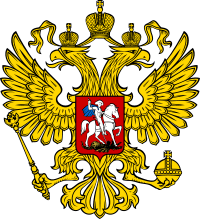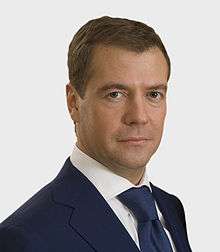Prime Minister of Russia
| Prime Minister of the Russian Federation Премьер-Mинистр Российской Федерации | |
|---|---|
|
| |
| Style |
Mr. Chairman By name and patronymic (currently Dmitry Anatolyevich) |
| Member of |
Government Security Council |
| Reports to |
President State Duma |
| Residence | White House |
| Seat | Moscow |
| Appointer | President of Russia, with the consent of the State Duma |
| Term length |
No fixed term Resigns before the newly elected President, but may be reappointed again |
| Constituting instrument | Constitution of Russia |
| Inaugural holder | Alexander Vorontsov |
| Formation | 8 September 1802 |
| Deputy |
First Deputy Prime Minister Deputy Prime Ministers |
| Website | Official website |
 |
| This article is part of a series on the politics and government of Russia |
The Chairman of the Government of the Russian Federation (Russian: Председатель Правительства Российской Федерации, Romanized: Predsedatel' Pravitel'stva Rossiyskoy Federatsii), colloquially referred to as the Prime Minister (Russian: Премьер-министр, Romanized: Prem'yer-ministr) is the head of the Russian government and the second most powerful figure of the Russian Federation. The official residence of the prime minister is Gorky-9 in Moscow Oblast, but his working residence is in Moscow (Russian White House). Under Article 24 of the Federal Constitutional Law On the Government of the Russian Federation, "heads the Government of the Russian Federation".[1] The Russian Prime Minister is considered the second highest position in the government, after the President.
Due to the central role of the President of Russia in the political system, the activities of the executive branch (including the Prime Minister) are significantly influenced by the head of state (for example, it is the President who appoints and dismisses the Prime Minister and other members of the Government; the President may chair the meetings of the cabinet and give obligatory orders to the Prime Minister and other members of the Government, the President may also revoke any act of the Government). The use of the term "Prime Minister" is strictly informal and is never used by the Russian Constitution, Federal Laws and other laws.
The current prime minister is Dmitry Medvedev of United Russia, who was appointed on May 8, 2012.[2]
Historical background
Imperial period
Early prime ministers

Since the office evolved rather than being instantly created, it may not be totally clear-cut who was the first Prime Minister. Since the 18th century, a modern system of public administration was going to be created in Russia, including the formation of bodies whose powers are similar to the powers of the modern Russian Government. However, these bodies had been only Advisory functions, and had no independence. The office of Chairman of those bodies were more decorative and do not bear any responsibility, besides, simultaneously the position of Chairman could hold several people. For example, immediately after the creation of the first governmental body of the Russian Empire, headed by six people.
From 1802 to 1905, the Chairman of the Comittee of Ministers, referred to as the prime minister, was appointed by the Emperor.
1905 — 1917
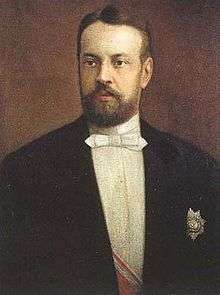
From 1905 to 1917, the Chairman of the Council of Ministers, referred to as the prime minister, was appointed by the Emperor.
The modern post of Prime Minister appeared in 1905, after the transformation of the Committee of Ministers to the Council of Ministers (full government of Russia). 6 November 1905, Sergei Witte was appointed the first Prime Minister of Russia.
The position of Chairman of the Council of Ministers of the Russian Empire, lasted 12 years, during this time, 7 people took this post (one twice). The position was abolished after the Russian revolution, the abdication of Nicholas II from the throne and the formation of the Provisional government.
Provisional Government

During the Russian Provisional Government in 1917, the official title of the prime minister was "Minister-Chairman of the Russian Provisional Government". This position was held by only two people, Georgy Lvov and Alexander Kerensky.
The position lasted about six months, and after the October Revolution, was replaced by Chairman of the Council of people's Commissars of the Russian SFSR.
Soviet period
In the era of the Soviet Union, the head of government was the Chairman of the Council of People's Commissars (until 1946) and the Chairman of the Council of Ministers (after 1946). People who held those positions are sometimes referred to as the prime ministers. They may have also been referred to as Premier of Ministers, or simply premier.
Post-Soviet period
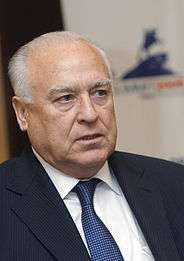
Currently, the formal title is the Chairman of the Government of the Russian Federation.
After the election of Boris Yeltsin, President of Russia, the head of the government was personally Yeltsin. He headed the Russian SFSR Council of Ministers (16 May 1992, the Council of Ministers of the Russian Federation) about six months. In fact, Yeltsin was the first Head of Government of Russia after the dissolution of the Soviet Union, however he was not the Prime Minister. After Yeltsin, Acting Prime Minister became Yegor Gaidar, but the Russian Supreme Soviet refused to approve him as Prime Minister. 14 December 1992, the Prime Minister was appointed Viktor Chernomyrdin.
Duties and competences
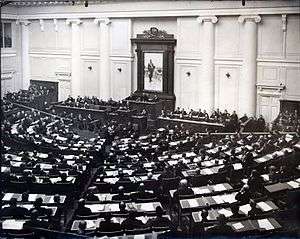
In general, the Prime Minister serves more of an administrative role, nominating members of the Cabinet and implementing domestic policy. In accordance with the federal constitutional law "On the Government of the Russian Federation" the Prime Minister exercises the following duties:
- determines the operating priorities of the Government and organizes its work in accordance with the Constitution, federal constitutional laws, federal laws and Presidential decrees
- submits to the President proposals on the structure and functions of the central institutions of the executive branch (e.g. ministries and federal agencies);[3]
- nominates the vice prime ministers, federal ministers and other officers and presents them to the President;
- submits to the President proposals on punishment and rewards of the Government members;
- represents the Government as an institution in foreign relations and inside the country;
- heads the sessions of the Government and its Presidium where he has the decisive vote;
- signs the acts of the Government;
- distributes duties among members of the Government;
- systematically informs the President about the Government activities;
- report annually to the State Duma about the Government activities;
The Prime Minister is ex officio a member of:
- The Security Council of the Russian Federation;
- The Council of the Heads of Government of the Commonwealth of Independent States;
- The Supreme State Council of the Union State of Russia and Belarus;
- The Council of the Heads of Government of the Shanghai Cooperation Organization;
- The Interstate Council of the Eurasian Economic Community (EurAsEC);
Appointment
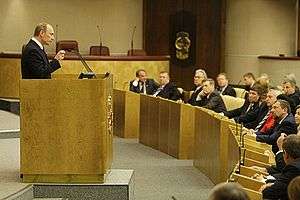
Initially, the Prime Minister appointed by the Emperor of Russia, without the consent of the candidate to the State Duma.
In Soviet times, Prime Minister of the Russian SFSR (as well as the Prime Ministers of the other Soviet republics) was appointed directly by the General Secretary of the CPSU, without the approval of candidacy with the Supreme Council of the USSR and RSFSR.
Currently Prime Minister is appointed by the President of Russia, subject to the consent of the State Duma (before 1993 the Supreme Soviet). Unlike most other "Prime Ministers", who are also elected members of the legislative body or parliament, the Chairman of the Government of Russia can be any Russian citizen, as long as they do not also hold citizenship of another country.
Under law, the President shall nominate a new Chairman of the Government within two weeks of the resignation of a previous government or inauguration ceremony of President. The State Duma is to discuss the matter within two weeks of the nomination and make a decision. The procedure of granting consent by the parliament is usually preceded by several days of comprehensive consultations and interviews of the candidate by the parliamentary factions. Should the State Duma decide to give the President its approval, the President may immediately sign the respective appointment decree. Should the State Duma refuse to give its approval, the President will have to nominate another (or the same) candidate within one week of the rejection of the previous candidate.[4]
Should the State Duma reject candidates nominated by the President for three times consecutively, the President shall dissolve it and call a new election, while the Prime Minister shall be appointed by the President without participation of the Duma. The State Duma may not be dissolved on these grounds during the first year after parliamentary elections, the last six months of the incumbent President's term, as well as in time of emergency, or war and in the event that the State Duma has initiated the impeachment of the incumbent President.
Other members of the Russian Government are appointed and dismissed by the President upon recommendation of the Chairman.
Results of voting on the appointment of the Prime Minister
| Candidate | Date | Total deputies | "Behind" | "Against" | Abstaining | No vote | Result | |
|---|---|---|---|---|---|---|---|---|
| The vote in the Supreme Soviet | ||||||||
| Yegor Gaidar | December 9, 1992 | 1040 | 467 | 44.9% | 486 | 26 | 61 | Not approved |
| Viktor Chernomyrdin | December 14, 1992 | 1040 | 721 | 69.3% | 172 | 48 | 1 | Approved |
| The vote in the State Duma | ||||||||
| Viktor Chernomyrdin | August 10, 1996 | 443 | 314 | 70.9% | 85 | 3 | 48 | Approved[5] |
| Sergey Kirienko | April 10, 1998 | 443 | 143 | 32.3% | 186 | 5 | 116 | Not approved[6] |
| April 17, 1998 | 443 | 115 | 25.9% | 271 | 11 | 153 | Not approved[7] | |
| April 24, 1998 | 443 | 251 | 56.7% | 25 | 39 | 135 | Approved[8] | |
| Viktor Chernomyrdin | August 31, 1998 | 443 | 94 | 21.2% | 253 | 0 | 98 | Not approved |
| September 7, 1998 | 443 | 138 | 31.2% | 273 | 1 | 32 | Not approved | |
| Yevgeny Primakov | September 11, 1998 | 443 | 317 | 71.6% | 63 | 15 | 49 | Approved |
| Sergei Stepashin | May 19, 1999 | 443 | 301 | 67.9% | 55 | 14 | 70 | Approved |
| Vladimir Putin | August 16, 1999 | 443 | 233 | 52.6% | 84 | 17 | 105 | Approved |
| Mikhail Kasyanov | May 17, 2000 | 441 | 325 | 72.7% | 55 | 15 | 52 | Approved |
| Mikhail Fradkov | March 5, 2004 | 445 | 352 | 79.1% | 58 | 24 | 13 | Approved |
| May 12, 2004 | 445 | 356 | 80% | 72 | 8 | 11 | Approved | |
| Viktor Zubkov | September 14, 2007 | 445 | 381 | 85.6% | 47 | 8 | 9 | Approved |
| Vladimir Putin | May 8, 2008 | 450 | 392 | 87.1% | 56 | 0 | 0 | Approved |
| Dmitry Medvedev | May 8, 2012 | 450 | 299 | 66.4% | 144 | 0 | 0 | Approved |
Removal from office
The Prime Minister may be dismissed by the President at any time at the President's own discretion. The Chairman may also tender his resignation to the President on his own initiative. The President may reject such resignation and oblige him to work further. The Prime Minister and the whole government are constitutionally obliged to resign after the inauguration of a newly elected President. The resignation of the Prime Minister automatically means the resignation of the whole government as a body.
Under certain circumstances, the President may also theoretically be forced to dismiss the Chairman and the whole government under pressure of the State Duma. For that to happen the State Duma has to pass a censure motion against the Government twice within three months. Normally, in this case the President has the right to choose whether to sack the government or to dissolve the Duma (and if the Duma passes the censure motion just once, the President may also choose "not to agree" with the decision of the Duma, which technically means that neither the cabinet nor the Duma are dismissed).
However, within one year from parliamentary elections the dissolution of the Duma is impossible on these grounds. That is why in this case the President does not have any other option but to dismiss the Government (even if he totally supports it). However, the President is theoretically free to appoint the very same person as an acting head of the cabinet for an indefinite period of time should finding a compromise with the parliament turn out to be impossible.
Term of office
Initially the term of office of the Prime Minister was not formally identified. The head of the government served in his post for as long as the Emperor thought it necessary.
In Soviet times, the service life of the Prime Minister also had a time limit. Chairman Council of Ministers of the Russian SFSR served in the position until he was dismissed the General Secretary of the Communist Party of the Soviet Union.
The term was introduced after the creation of the post of the President of Russia. Government became subordinated to the President, so the Prime Minister must resign along with the President, but may be appointed again. From 1991 to 1996, the maximum term of office of the Prime Minister was 5 years old. After creating the new Constitution of Russia, the term of office of the President, and therefore the term of office of the Prime Minister, was shortened to 4 years. In 2012, after amendments to the Constitution the term of the President and Prime Ministre was increased to 6 years.
Acting Prime Minister
Russian law does not specify who should become acting Prime Minister in case of his incapacity. Despite the presence of several Vice Prime Ministers, the President appoints the acting Prime Minister, and not always the acting Head of Government is his Deputy. Very often, the acting Prime Minister later proposed the State Duma as the new Prime Minister.
Succession of the presidency

In case of the President's death, resignation or impeachment, the Prime Minister becomes a temporary president until new presidential elections which must take place within three months. The Prime Minister acting as president may not dissolve the State Duma, announce a referendum or propose amendments to the Constitution.
The Chairman of the Federation Council is the third important position after the President and the Prime Minister. In the case of incapacity of the President and Prime Minister, the chairman of the upper house of parliament becomes acting head of state.[9][10]
List of heads of government
Living former Prime Ministers
As of December 2016, there are seven living former Prime Ministers. The most recent death of a former Prime Minister was that of Yevgeny Primakov (1998–1999) on 26 June 2015, aged 85.
| Name | Term of office | Born |
|---|---|---|
| Ivan Silayev | 1990–1991 | 21 October 1930 |
| Sergey Kiriyenko | 1998 | 26 July 1962 |
| Sergei Stepashin | 1999 | 2 March 1952 |
| Vladimir Putin | 1999–2000 and 2008–2012 | 7 October 1952 |
| Mikhail Kasyanov | 2000–2004 | 8 December 1957 |
| Mikhail Fradkov | 2004–2007 | 1 September 1950 |
| Viktor Zubkov | 2007–2008 | 15 September 1941 |
See also
- Sergei Stepashin
- Sergei Kiriyenko's Cabinet
- Yevgeny Primakov's Cabinet
- Mikhail Fradkov's Second Cabinet
- Dmitry Medvedev's Cabinet
References
- ↑ Федеральный конституционный закон «О ПРАВИТЕЛЬСТВЕ РОССИЙСКОЙ ФЕДЕРАЦИИ» kremlin.ru 17 декабря 1997.
- ↑ Дмитрий Медведев утверждён на посту председателя правительства России - Первый канал (in Russian).
- ↑ "The Constitution of the Russian Federation: Section One, Chapter 6. – The Government of the Russian Federation". Bucknell University. Retrieved 2014-07-14.
- ↑ CONSTITUTION of the RUSSIAN FEDERATION Chapter 6. The Government of the Russian Federation
- ↑ Transcript of the meeting
- ↑ Transcript of the meeting
- ↑ Transcript of the meeting
- ↑ Transcript of the meeting
- ↑ "Пост Председателя Совета Федерации РФ – это третий пост в стране. В случае недееспособности президента и премьера именно председатель верхней палаты парламента должен возглавить государство."
- ↑ "Почему у нас третье лицо в государстве Председатель Совета Федерации? Потому что это федерация, он не распускается, он действует постоянно." - Сергей Шахрай
External links
- Official Website of the Prime Minister of Russia (Russian)
- Official Site of the Government of Russia (Russian)
